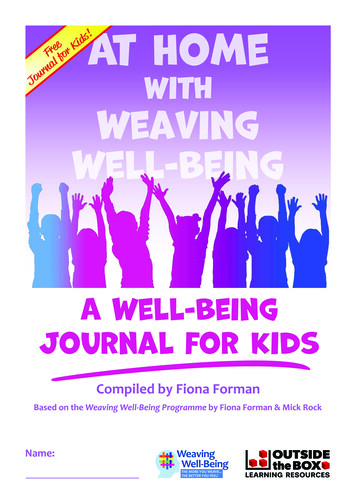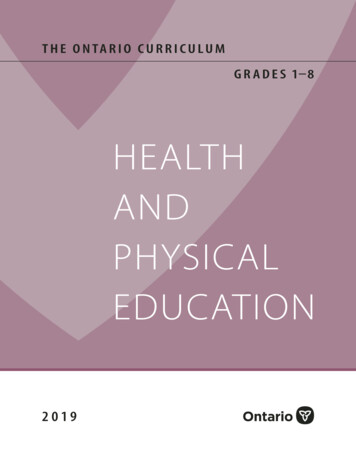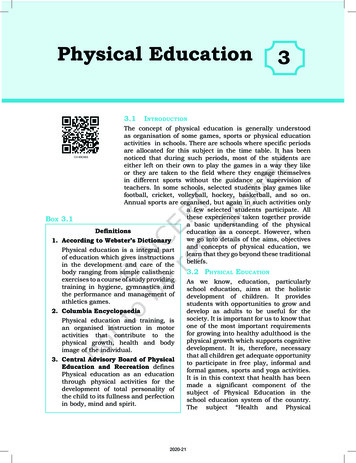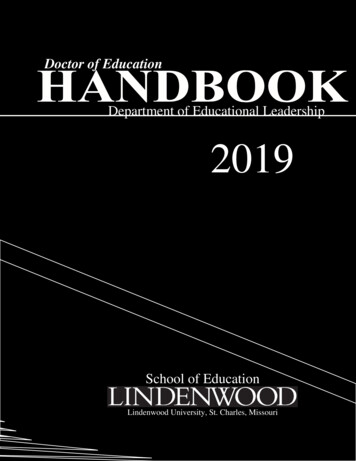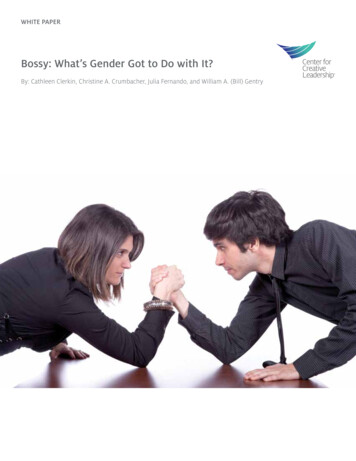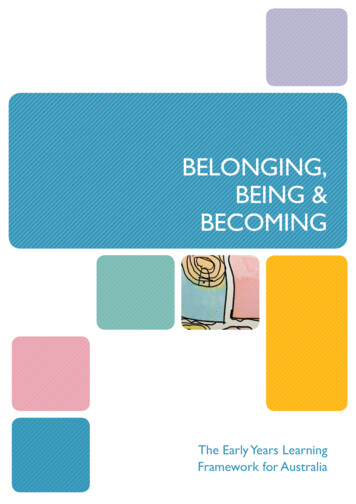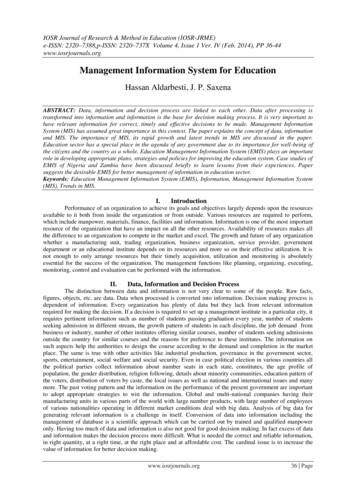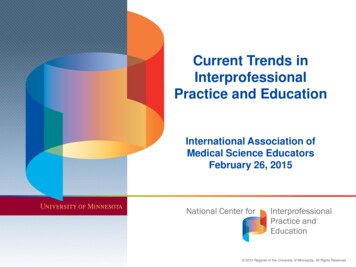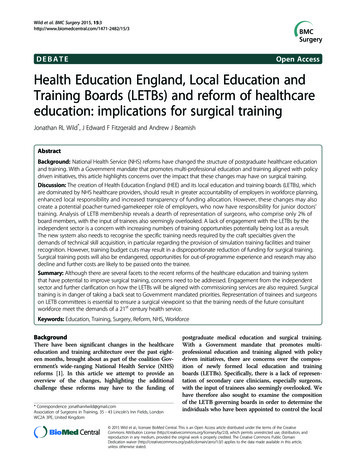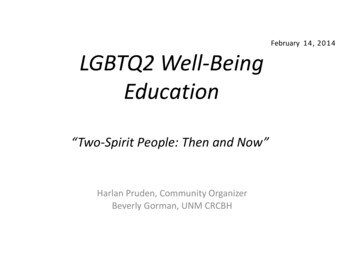
Transcription
February 14, 2014LGBTQ2 Well-BeingEducation“Two-Spirit People: Then and Now”Harlan Pruden, Community OrganizerBeverly Gorman, UNM CRCBH
Two-Spirit Then and Now:Sex, Gender and Sexuality in Historical &Contemporary Native AmericaPresented byHarlan Pruden (Nehiyawewin/First Nations Cree),NorthEast Two-Spirit Society
LGBTQ2 Well-Being Education Series Goal: to educate, inform, empower, and engageproviders about the well-being of the NativeLGBTQ2 community
LGBTQ2 Well-being Series Educators Adrien Lawyer, Director, Transgender ResourceCenter of New MexicoAlaina George (Diné), Tele-Health Coordinator,Albuquerque IHSAlma Rose Silva-Bañuelos, Director, UNM LGBTQResource CenterAvron Kriechman, MD, Assistant Professor, Child,Adolescent & Family Psychiatrist, UNM CRCBHBeverly Gorman (Diné), MCSW/MBA, Researcher &Program Manager, UNM CRCBHChris Fore (Choctaw), PhD, Albuquerque HISHarlan Pruden (First Nations Cree), Co-FounderNorth East Two Spirit Society (NE2SS)Jason Jones (Mestizo), LISW, Five Sandoval IndianPueblos Inc. Behavioral HealthLouva Hartwell (Diné), Director NativeOUTNathaniel Sharon, MD, Child & AdolescentPsychiatry Fellow, UNM Department of PsychiatryTerra Matthews-Hartwell (Tsimshian/Carrier),NativeOUT
Objectives Objective #1 - Gain knowledge of current dataon the Native and Two-Spirit subpopulations. Objective #2 - Increase familiarity history ofTwo-Spirit people and tradition. Objective #3 - Gain access to more resourcesfor additional learning and referrals.
States with Populations over100,000 AlaskaArizonaCaliforniaFloridaNew MexicoTexas NEW YORKNorth CarolinaMichiganOklahomaWashington
Diversity of Native PeoplesThere are more than 5.6 million indigenous Americans inthe United States and another 1.3 million in Canadadivided into more than 1,162 recognized Nativegovernments:– 630 First Nations governments or bands spreadacross Canada,– 596 in the United States, and hundreds more in variousstages of the recognition process.– Approximately 225 Native languages are spoken in theUnited States and another 50 in Canada. A far greaternumber of North American indigenous languages are extinctor are no longer spoken fluently. These languages are divided into fifty language families, many asdifferent from each other as Romance (e.g. Italian) from SinoTibetan.
Gender vs. Sexual Orientation Sexual orientation refers to an enduringemotional, romantic, sexual, or affectionalattraction toward others, usually conceived asclassifiable according to the sex of the personswhom the individual finds sexually attractive. Gender is socially defined and dictates oneplace and role with one’s community.
Concept of Two-Spirit The term/identity of two-spirit does not make senseunless it is contextualized within a Native Americanframe Two-Spirit within a traditional setting was a genderanalysis and not a sexual orientation Today, most people associate the term with LGBTNatives; however, the work of the two-spiritorganizations is more akin with the traditionalunderstanding
Two-Spirit Beginning of Time – First Contact 1492 to 1990 - berdache 1990 to Present - Two-Spirit
Roles of the Two-Spirit MediatorsSocial WorkersName GivingLove Potions / Match MakerSun DanceWere Holy people, told the future and brought goodluckBoy’s & Girl’s Puberty CeremonyPeace-Makers for the TribeJoined war partiesWere doctors/medicine people
Dance to the Wingkté
Some Two-Spirit NamesNationTerm“Loose” translationAcomaMale-bodied: Kokwi'maAleutMale-bodied: Ayagigux'Female-bodied: Tayagigux'"man transformed into a woman""woman transformed into a man"ArapahoMale-bodied: Haxu'xan (singular),Hoxuxuno (plural)"rotten bone"ArikaraMale-bodied: Kuxa'tAssiniboineMale-bodied: WinktanAtsegwiMale-bodied: Yaawa:Female-bodied: BrumaiwiBlackfoot/BlackfeetSiksikaMale-bodied: Aakíí'skassi or Aawoowa’kiiSouthern PeiganMale-bodied: Aakíí'skassiFemale-bodied: Saahkómaapi'aakííkoanCheyenneMale-bodied: He'eman (singular),He'emane'o (plural) (hee "woman")Female-bodied: Hetaneman (singular),Hatane'mane'o (plural) (hetan "man")Chickasaw, ChocktawMale-bodied: HatukiklannaFemale-bodied: hatukholba"acts like a woman""acts like a woman""boy-girl"
NationTerm“Loose” translationChumashIneseñoMale-bodied: agíVentureñoMale-bodied: aqi or axiMale-bodied: Elha ("coward")Female-bodied: WarrhamehMale-bodied: napêw iskwêwisêhotFemale-bodied: iskwêw ka napêwayatMale-bodied: ayahkwêwFemale-bodied: înahpîkasohtMale-bodied: IskwêhkânFemale-bodied: napêhkânMale-bodied: Bote/Bate/Badea man who dresses as a womana woman dressed as a mana man dressed/living/accepted as a womana woman dressed/living/accepted as a manliterally ‘fake woman’ – not negativeliterally ‘fake man’ – not negative"not man, not woman"CocopaCreeCrowDakotaSantee SiouxMale-bodied: WinktaFlatheadGros VentreGosiuteHidatsaHopiInterior SalishMale-bodied: Ma'kaliMale-bodied: AthuthMale-bodied: TuvasaMale-bodied: MiatiPuebloMale-bodied: Ho'va"to be impelled against one's will to act thewoman," "woman compelled"
NationTermHuchnomMale-bodied: Iwap kutiIllinoisMale-bodied: IkouetaFemale-bodied: Ickoue ne kioussaMale-bodied: QuariwarmiIncaIngalik (Deg Hit’an)InuitJuanenoKarankawaKawaiisuKeresa (Pueblo)KlamathKootenai (Kutenai)Kumeyaay (Diegueno)Tipai, KamiaMale-bodied: Nok'olhanxodeleaneFemale-bodied: ChelxodeleaneMale-bodied: SipiniqMale-bodied: Kwit“Loose” translation"hunting women""woman pretenders""man pretenders""infant whose sex changes at birth"Male-bodied: MonaguiaMale-bodied: Hu'yupǐzAcomaMale-bodied: Kokwi'maLagunaMale-bodied: Kok'we'maMale-/Female-bodied: Tw!inna'ekMale-bodied: Kupatke'tekFemale-bodied: TitqattekFemale-bodied: Warharmi"to imitate a woman""pretending to be a man"
NationTermLagunaLakotaMale-bodied: Kok'we'maTeton SiouxMale-bodied: WinkteFemale-bodied: Bloka egla wa ke“Loose” translation"['wants' or 'wishes'] to be [like] [a] woman."A contraction of winyanktehca"thinks she can act like a man"LuisenoSan Juan CapistranoMale-bodied: CuitMountainMale-bodied: UluquiMaiduMiamiMountain (Northeastern)Male-/Female-bodied: SukuNisenan (Southern)Male-bodied: Osa'pu (osa "woman")Male-bodied: MihdackaMale-bodied: Ilyaxai'Female-bodied: KwiraxameMale-bodied: WaupeengwoatarMescalero ApacheMi’kmaq (Micmac)Male-bodied: Nde'isdzanMale-bodied: Geenumu gesallageeMiwokMohaveMale-bodied: OsabuMaled-bodied: AlyhaFemale-bodied: HwameMandanMaricopamih-ha "woman""girlish""the white face," possibly the name of aparticular person who was two-spirit"man-woman""he loves men," perhaps correctly speltji'nmue'sm gesalatlosa "woman""coward"
NationTermMonoMale-bodied: Tai 'up(Monache, Western Mono)Male-bodied: WalusaNomlaki“Loose” translation"hermaphrodite"), tôhkêt ("boy who goesaround with the women all the time""hermaphrodite"Nuxálk (Bella Coola)Male-bodied: Sx’ǐntsDiné, Bi la’ Á’shglá’ii (FiveFingered Beings)(Navajo)"one in a constant state of change," "one whochanges," "being transformed““warrior/protector of”Ojibwa(Chippewa)Omaha, Osage, � or nadleeh (genderclass/category), nadl’éé’i (singular),nadl’éé’hé (plural)Female-bodied: Bá (suffix, singular), orbah, i.e. DilbáMale-bodied: AgokwaFemale-bodied: OkitcitakweMale-bodied: Mixu'gaOtoe, Kansa (Kaw)Male-bodied: Mixo'ge"instructed by the moon," "moon instructed“PapagoTohono O'odham &Akimel O'odham (Pima)Male-bodied: Wik'ovatNorthernMale-bodied: TüdayapiFemale-bodied: Moroni nohoTüvasaOwens Valley (Eastern Mono)Male-bodied: TüdayapiSouthernMalebodied: Tüwasawuts orMa:ai potsMale-bodied: Panaro bobum piPaiutePatwin"man-woman""warrior woman""instructed by the moon," "moon instructed""like a girl""dress like other sex""dress like other sex""he has two [sexes]"
NationTermPawneePomo (Kalekau, Kulanapa)Male-bodied: Ku'saatNorthernMale-bodied: Das (Da "woman")SouthernMale-bodied: TǃunMale-bodied: M'netokwePotawatomiQuinaultSalinanSanpoilSauk (Sac), FoxShoshoneUteTakelmaMale-bodied: Keknatsa nxwixwFemale-bodied: Tawkxwa nsixwMale-bodied: Coya“Loose” translation"supernatural, extraordinary," Manito plusfemale suffix"part woman""man-acting"Male-bodied: St’a miaMale-bodied: I-coo-coo-a or Äyä‘kwä "hermaphrodite""man-woman"BannockMale-bodied: Tuva'saLemhiMale-/Female-bodied: TübasaMale-bodied: Taikwahni tainnapa'Female-bodied: Waip:ü suŋweor taikwahni wa'ippena'GosiuteMale-bodied: TuvasaPromontory PointMale-bodied: Tubasa waip:NevadaMale-bodied: Tainna’wa’ippeor waip: siŋwaFemale-bodied: NüwüdückaSouthernMale-bodied: TuwasawitsMale-bodied: Xa'wisa"sterile""woman-half""sterile woman""man-woman" or "half woman""female hunter"
NationTermTenino (Warmsprings)Male-bodied: WaxlhaTewa (Pueblo)Male-/Female-bodied: KwidoTiwa (Pueblo)Isleta“Loose” translation"coward""boy whose sex changes at birth""effeminate man""mannish woman"TübatulabalMale-bodied: LhunideMale-bodied: GatxanMale-bodied: WⁿcitcMale-bodied: Kanâ'ts' orMa̱hana̱'a̱xFemale-bodied: Mi'yuutaMale-bodied: HuiyWailakiWappoWinnebago (Ho-Chunk)WishramYanaMale-bodied: CleleMale-bodied: WósMale-bodied: ShiangeMale-bodied: Ik!e'laskaitMale-bodied: Lô ya"unmanly man"TlingitTsimshianYokuts (Mariposa)KocheyaliMale-bodied: Tonoo'tcimPaleuyamiMale-bodied: Tono'cimTachi (Tulare)Male-bodied: Tonochim orLokowitnonoMichahaiMale-bodied: Tono'cimYaudanchiMale-bodied: TongochimWaksachiMale-bodied: Tai'yap"undertaker"
NationTerm“Loose” translationYuma (Quechan)Male-bodied: Elxa'Female-bodied: Kwe'rhame"coward""man-woman”"what kind of people are those two""man-woman," perhaps spelt the same asthe Chugach"different, distinct person""woman-like""man-like"YurokAlutiiq (Sugpiaq, Pacific Eskimo,Southern Alaskan Yup'ik)ChugachMalebodied: Aranu:tiqFemalebodied: TyakutyiKoniag (Koniagmiut)Malebodied: AkhnuchikSiberian Yup'ik (St. LawrenceIsland, Yuit, Western AlaskanYup'ik)Male-bodied: Anasik or YukallakuyaaqFemale-bodied: UktasikKusquqvagmiut (Kuskowagamiut,Kuskokwim river, Central AlaskanYup'ik)Male-bodied: AranaruaqFemale-bodied: AngutnguaqMale-bodied: WergernZapotecMale-bodied: MuxeZuniMale-bodied: Lha'manaFemale-bodied: KatotseYup'ik"behave like a woman""boy-girl"
Other cultures outside of NorthAmerica with Gender DiversityASIAKoreamudangSiberian ChukchisMale-bodied: Yirka'-la'ul ("softman")Female-bodied: Qa'cikicheca("similar to a ONESIABorneobasir (among the Ngaju ofKalimantan)manang bali (among the Iban)Sulawesibasaja (among the Toradjas)bissu (among the ALAYSIASingaporemak nyahAFRICALugbaraokule (male-bodied)agule (female-bodied)Zuluisangoma
Who Were Some of the TwoSpirit People from Years Ago?Osh-Tisch (Crow) in funeral dress, 1928
Two men from Moose Mountain
We-Wha (Zuni Nation)
Ozaawindib ("Yellow Head"), Ojibwe
Ozaawindib/OjibweThe Ojibwe share a fascinating system of beliefs. One such belief is that the two genders are not male and female, but animate and inanimate. This allowed theOjibwe to develop a complex society in which "traditional" gender roles were not important. Members of the tribe contributed to their communities and familiesin whichever way they felt was best. They were the career moms and stay-at-home dads centuries before these terms became popular. In fact, many Ojibwewarriors were transgendered. Known as egwakweg, these transsexuals were honored and revered because they were "two-spirited", or niizh manidoowag. Itboggles the mind to think that these so-called "primitive" people were so many centuries ahead of their time, because even in the 21st century most "civilized"societies have yet to come to terms with transgender issues.While some people may smirk at the thought of transgendered warriors, history shows that the Ojibwe were skilled tacticians when it came to art of war. In 1745,armed with British guns, the Ojibwe defeated the Sioux and drove them out of their southern territories to the Dakotas. They defeated the Lakota and Meskwaki(Fox), driving the Fox out of northern Wisconsin. Allied with the French during the Seven Years' War, the Ojibwe fought against the powerful Iroquois Confederacyand the British. They lost, of course, but the Ojibwe didn't give a hoot about adversity or the odds stacked against them. They fought against the United Statesduring the War of 1812, siding with the British. Although historians conclude that the War of 1812 ended in a draw, it could have been a decisive American victoryif not for the Ojibwe, who were determined to prevent American settlers from stealing their territorial lands.The most well-known of these transgendered warriors was Ozaawindib, whom the Europeans called "Yellow Head". John Tanner, an interpreter who lived amongthe Native Americans for thirty years, was raised by the Ojibwe in the late 18th century. In his 1830 book, Tanner describes Ozaawindib: "This man was one ofthose who make themselves women, and are called women by the Indians." Tanner also recalled that he was once the center of Ozaawindib's affections. Thewarrior, who already had several husbands (polygamy was a common practice among certain tribes), made numerous advances toward Tanner. However, theOjibwe egwakweg lost interest in Tanner when he became the third wife of Chief Wenji-Dotaagan.History records Ozaawindib as being a courageous warrior. His position within the tribe was that of Makandwewininiwag, known as a "pillager". These Ojibwepillagers were much like the modern-era Marine Corps; the first to arrive on the scene of battle. The pillagers served as an advance guard, leading the invasion ofDakota territory. Today, the legacy of this transgendered warrior can be seen in place names around Minnesota. Lake Itasca's Yellow Head Point was named in hishonor.
Charlie The Weaver (right) and friend, 1895
Quechan kew’rhame (Quechan), 1890
Chief Barcheeampe (1850) or Pine LeafChief Barcheeampe (1850) or Pine Leaf - While always dressing in female clothing, she was learned inhorse keeping, hunting and warfare, mostly against the Blackfoot. She had at least four female wives andearned a strong voice in the tribes council, ranking the third person in the whole tribe of 160 lodges. In1854 she was killed by Gros Ventres Indians near Fort Union.
Lozen and Dahtetse (Chiricahua Apache) fromGeronimo’s Band, 1886
Lozen and DahtetseLozen was a Chiricahua Apache warrior born in the late 1840s. The younger sister to the famous leader Victorio and a leader in her own right, she began ridinghorses at age seven. Lozen learned the Apache art of war as taught to her by her brother, and fought with other Apache warriors in skirmishes in the states ofNew Mexico, Arizona, and Chihuahua. Throughout her life, she was never interested in the traditional roles of Apache women, never married a man, and wasdescribed as being more masculine than other men within the tribe. When she was not accompanying the men in raiding parties, she would engage in the roughgames of the men and earned their respect as an athlete. Victorio described her as “my right hand” and “a shield to her people.”Lozen was a renowned medicine woman, possessing extensive knowledge of the medicinal properties of plants and minerals. She was also famous for her abilityto detect her enemies by means of a ritual in which she sang, extending her arms, and turned in a circle until the palms of her hands tingled, letting her knowfrom which direction they were approaching. Upon Victorio’s death, she went on to join the famed Native American resistance leader Geronimo (Apache name:Goyatla, “One Who Is Yawning”). She eluded her capture many times until she was finally surrounded along side Geronimo in 1886. She died as a prisoner of warat Mount Vernon in Mobile, Alabama of tuberculosis at age 50, never to see her homeland in the Southwestern USA ever again.Dahteste was a Mescalero Apache woman and companion of Lozen. Unlike the masculine description of Lozen, Dahteste was a well-groomed, beautiful womanwho took pride in her appearance and dressed in feminine attire. Although she rode and fought just as well as Lozen, she was described as carrying herself withmore sophistication. Dahteste was fluent in English and acted as translator for the Apache people. She also became a mediator and trusted scout for the U.S.Calvary. Her dual loyalties to the Apache people and the US Army did not keep her from being arrested alongside Geronimo in 1886. She was taken as a prisonerof war and shipped off to St. Augustine, Florida where she remained for eight years. While in Florida she managed to survive pneumonia and tuberculosis.Later on, she was shipped to Fort Sill, Oklahoma where she remained for another nineteen years before given permission to join the Mescalero Apache in NewMexico. Dahteste was able to live out the rest of her life among her people until she died of old age. Eve Ball, who interviewed Dahteste in New Mexico, said, “Icould hardly believe my good fortune in being permitted to know this courageous woman,” and “Dahteste to the end of her life mourned Lozen.”There is one surviving picture of Dahteste and Lozen. They are sitting close together, along with Geronimo and other warriors in front of the train that is takingthem away in cattle cars to exile in Florida. The physical proximity of the two women, however, is often disrupted by biographers, despite evidence of theircompanionship in battle and during their exile. Their images are isolated into two separate pictures, just as their biographies tend to downplay their emotionalcloseness to each other. Members of the Two-Spirit community have reintegrated the visual and biographical images of Lozen and Dahteste so that they areonce again united.
Hastiin Klah, Navajo
An Unidentified Navajo
Balboa's dogs killing our Two-Spirit PeoplePainting of the story of Captain Vasco Núñez de Balboa, the Spanish conquistador who in 1513, during thecourse of his journeys, discovered a group of indigenous men in Panama who had engaged in homosexualrelations. Taking the men to a nearby mountain clearing, Balboa had the men stripped naked, then set hisdogs on them, allowing the animals to tear the men to shreds. Various chronicles of the Spanish conquestof the Americas provide accounts of homosexuality among several of the indigenous peoples inhabiting theregion -- an element which, together with others, served to provide "moral" justification for the genocidewhich marked the conquest.
Indian life for the Two-Spiritduring the reservation system European and Native beliefs clashed.Missionaries fed the two-spirit people to the dogs.Christian beliefs forced upon Native people.Native Children placed in government schools.Cut the two-spirit male’s hair and forced them todress in men’s clothing and girls to wear dresses Intimidation and out-right violence of the Churchesand Government Agents, many Chiefs were reluctantto defend their two-spirit people. Out love and respect, Two-Spirit were asked to gounderground in order to protect them.
A photo of Carlisle Indian Industrial School, (1879 - 1918), was an Indian Boarding School in Carlisle, Pennsylvania. Foundedin 1879 by Captain Richard Henry Pratt at a disused barracks in Carlisle, Pennsylvania. The so-called “noble experiment” wasa failed attempt to forcibly assimilate Native American children into the culture of the United States. The United States ArmyWar College now occupies the site of the former school."It seems curious that church people, humanitarians, and idealists should fall so much in love with Pratt. He was a quiteordinary army officer who had developed a marked ability for knocking the spirit out of the Indians and turning them into docilestudents who would obey all orders. Pratt was a domineering man who knew only one method for dealing with anyone whoopposed his will. He bullied them into submission.“250 million Indigenous people died after contact with the Europeans. By 1920, 99% of the Native Peoples were wiped out.1920 is two-years after the closing of Carlisle Indian Industrial School.
Defining Characteristics of TwoSpirit & Native Peoples Historical trauma;Intergenerational trauma;Band/Tribal membership;Half-truths, misconceptions, stereotypes pervade allaspects our Indian life and history; and We are small population – however it is preciselybecause our number are so small that our communityshould be declared a top priority – once we are gone– we are gone.
What is Historical Trauma? Historical traumais cumulative emotional and psychological wounding over the lifespan andacross generations, emanating from massive group traumacumulative exposure of traumatic events that affect an individual and continuesto affect subsequent generations– The trauma is held personally and transmitted over generations; thus, evenfamily members who have not directly experienced the trauma can feel theeffects of the event generations later Historical trauma response– is a collection of features in reaction to massive group trauma (genocideexperienced by the Native American people in the US)(Brave Heart, 1995,1998, 1999, 2000) Takini Network
What is historical trauma?A combination of immense losses and traumatic eventsthat are perpetrated upon an entire culture throughpolicy and upheld by the judicial system. For NativePeoples, these losses include: Culture Language Land People (deaths due to diseases and war) Way of life Ceremonies Family structure (forced into boarding schools)
“Emotional andpsychologicalwounding .”(Maas, M.& Tom, N.2008; Yellow HorseBrave Heart, 2003)
“ .over thelifespan and acrossgenerations”(Maas, M.& Tom, N.2008; Yellow HorseBrave Heart, 2003)
1.2.3.4.Confronting historical traumaUnderstanding the traumaReleasing our painTranscending the trauma Takini Network
SPIRITUALMENTAL(Maas & Tom, 2008;Yellow Horse BraveHeart, 2003)PHYSICALEMOTIONAL
Two Spirit Society Healing ProcessA couple of examples of the healing work in theTwo-Spirit Community: NE2SS weekly Dance LessonsTwo-Spirit GatheringsTwo-Spirit Pow-WowsTwo-Spirit Drum GroupsRestoring of Ceremonies:– Naming Ceremony– Sun Dance
Resources Two-Spirit Resource Directory – www.ne2ss.org Healing Circle Consultant Booklet Resource Guide, 2nd Ed., cs/healing circle consultant guide second edition/20 We R Native www.wernative.org Northwest Portland Area Indian Health Board – We R Proud, Logos,Media, PSAs, etc.http://www.npaihb.org/epicenter/project/prt reports publications media campaigns#STD/HIV PowerPoint Slides NativeOUT http://nativeout.com Native Stand http://www.nativestand.com/
Harlan Pruden – harlan@ne2ss.org
a man who dresses as a woman a woman dressed as a man a man dressed/living/accepted as a woman a woman dressed/living/accepted as a man literally ‘fake woman’ – not negative literally ‘fake man’ – not negative Crow Male-bodied: Bote/Bate/Bade "not man, not woman
